As a defence coach, I am often perplexed by the narrative that our beautiful game is dominated by defence and that scoring tries is challenging with the existing rules and trends within the game.
Based on this thinking it must be equally difficult to win a game of rock-paper-scissors. Under normal circumstances it’s a 50/50 shoot out between two players as to which strategy would win. The beauty of this childhood game is that no one strategy is more effective than the other and that there is a complimentary counter strategy to beat each of the three strategies of the game rock-paper-scissors. Imagine, however, if you had a 3 second window to see your opponent’s strategy. Let’s say he chose rock and based on this, you chose paper. You might wonder what his has do with rugby? The answer is simple – the principle of “best option decision-making”.
The philosophy of this attacking principle is that at any point in time, the defensive team can only cover a limited amount of space on the field. Based on this, there will always be an opportunity somewhere to attack and exploit. Further explained, the defensive team typically has a policy in place as to how many players populate their defensive line. This is also referred to as the front line. Additionally, players are nominated to populate the kicking space behind the line, for example, the wingers and the fullback. Another consideration is the positioning of the defensive scrum-half. This could sometimes entail up to 4 players occupying the back field as the scrum-half often stands behind a defensive breakdown.
With the scenario above, you would have a maximum of 11 players in the front line, assuming the tackler is back on his feet. This is rare as there are at least 1-2 defenders on the ground or contesting the ball. Typically you could have 12 attackers versus 9 defenders and 70 meters of width. We have assumed that 3 attackers are in a ruck. I would like to add another variable which is a breakdown in the middle of the field, meaning that the defence has 2 sides to cover with 9 players. Based on this scenario the attacking team surely has a numerical advantage on at least one of those two sides to exploit (refer to the diagram below).
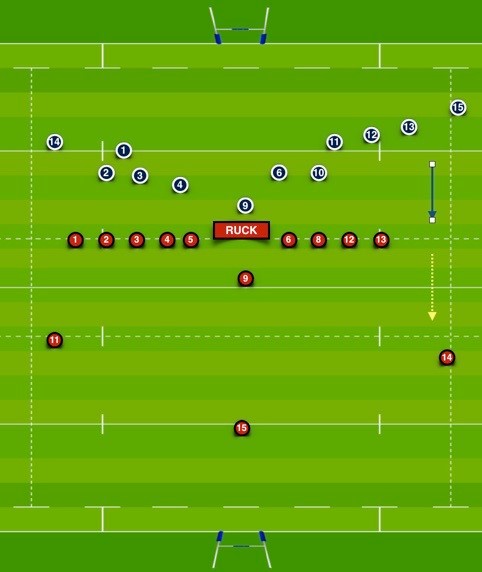
Cue the rugby equivalent of rock-paper-scissors with the added advantage of being able to see the defensive strategy being presented. The onus here is to identify the mismatch and execute the appropriate strategy of exploiting the mismatch. This is the principle of best option decision-making. Simple in theory and yet not simple enough to execute as frequently as it should be.
It would be appropriate at this point to revisit some Level One coaching theory, which states that teams can go forward in one of four ways, namely to run, pass, kick and maul. Whilst there are 4 strategies in comparison to the childhood game’s 3 options, the principles are exactly the same with one fundamental difference – it is only a 50/50 likelihood of winning – if you’re not looking at the opponent.
Let’s look at another more challenging scenario. A recent trend called the 13/2 defensive split has been employed by professional teams over the last 18 months. This scenario has the scrum-half and fullback covering kicking threats and uses the wingers to populate a stronger defensive front line. Running through this brick wall is often the equivalent of a rock trying to beat a rock. The example in the video below shows Ireland utilising the 13/2 split with relative success as they won the game in this year’s six nations, repelling the preferred running game of the Scottish.
The Scottish team preferred to run when the best option was the attacking kick. Fast forward to the next game of the same competition. In the video below, England had identified this strategy and employed the complimentary attacking kicks to beat the strong Irish defensive line. England scored twice to win the game.
The challenge it would seem is often down to coaching philosophy, where we often have preferences of style. It would go without saying that every team must have both an identity and a means of applying pressure that reflects the strengths of the team. This is not in question, however, often players are programmed into a rigid pattern that does not always adapt to the changing characteristics of space, time and numbers presented by the defensive line. Too often I hear coaches say we always exit in our own third or we always run the ball regardless of how teams defend against them. In reality the challenge is not the rules or trends of the game, however, it is a coach’s preference or unwillingness to take risks and make decisions, which conflict with their philosophy.
Attack coaches wanting to beat organised defences need to create a blue print that recognises these factors and incorporates them into training sessions. The aim is to have a dynamic yet simple plan to adapt in matches. If two teams are equal in playing ability, the team that makes better decisions will win. The beauty of best option decision-making is that it exists in every single second that the ball is in play and before every set piece.
We will unpack set piece attack and decision-making within a pattern in my next article. Here we will continue with the basic tenets of how to introduce best option decision-making in open play. This entails identifying whether to attack a linear space presented by a balanced (or strong) defensive line, or to attack a wide, lateral space presented by an imbalanced (bunched/holes) defensive line. Lastly the option to use the attacking kick (to regain possession) when there is no secondary defence behind the front line.
The key is to understand the players physiological decision-making process. This is explained below as: Assessment – Decision – Action. Assessment is the building block requiring players to being exposed to the various scenarios or space they may “see”. If a player can make the right assessment, it means he can identify and see the opportunity.
Based on the assessment the decision follows and refers to the “thinking” component of the process, where the player chooses the appropriate strategy. This starts slowly, but ultimately becomes split-second thinking once the visual cues are embedded from the repeated training process.
Lastly, the action or “do” is the strategic action of running, passing or kicking based on the information presented by the defence in training and matches. The players ability to correctly identify allows for the correlating decision and action to take place. The aim is to create these visual cues in the training environment.
The drill below is an example of creating three basic visual cues for the players to make the decisions and attempt to apply the complimentary strategy or best option based on the picture they see. This can be adapted to suit any teams’ pattern of creating and exploiting space, however, we have used the flyhalf in this instance as the playmaker.
1. Assessment – realignment and scanning
From a ruck scenario and using a trigger (whistle or break call), the players (both attack and defence) have 3 seconds to realign and populate the space allocated. During this realignment process the attackers have to look up and assess and identify if the defence is balanced or unbalanced, or has no cover behind. The coach typically stands near the ruck and gives the defence the spacing he wishes to create.

2. Decision-making and communication
Once the coach has finished his 3 second count, the attacking team must launch the attack. In order to have a coherent attack, a message must be fed to the flyhalf by the players outside – typically the outside backs have a better view of the defensive spacing. This improves the assessment process and places greater responsibility on the flyhalf to execute as opposed to do all of the decision-making on behalf of the team.
The three pictures below represent the three different environmental cues players are looking for: balanced, unbalanced defence and kick space scenarios.


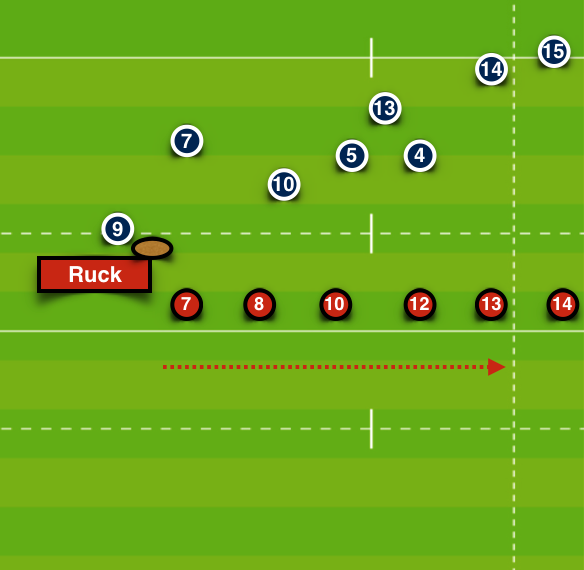
Lastly, once the assessment has been made and the decision communicated, the players need to execute and apply the appropriate and complimentary strategy to beat the defensive setup. We start with creating space against a balanced defence, which means that attackers need to attack a linear space between defenders. In this instance the playmaker needs to receive the ball on the run in an attempt to firstly win the gain line and secondly to manipulate the defenders (overloading the channel with supporting players) who are the running options (typically forwards). The playmaker attempts to isolate one defender and play one of his 3 running options who are presenting at pace between the defenders. Pace onto the ball is essential to create uncertainty in the defence. All three running forwards must anticipate the ball and support the receiver, with a view to connecting in the event of line break, offload or ensuing breakdown.
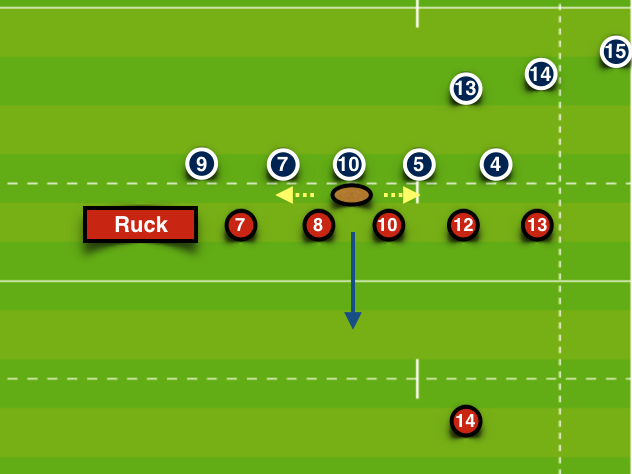
Next we look at exploiting a lateral space with unbalanced defence. In this instance it’s important that the flyhalf does not take the ball to the line and “eat up” all the space. He needs to receive the ball square, take a step and release the pass. Typically it takes 3 passes to exploit the opportunity with another back acting as a playmaker. In the two diagrams below, the forwards run the same pattern as before and become the decoys. The pass goes behind them to the backline receiver who looks to release to the outside backs. This is for illustrative purposes only and there is still nothing more effective than simple hands at pace to get width on the ball.
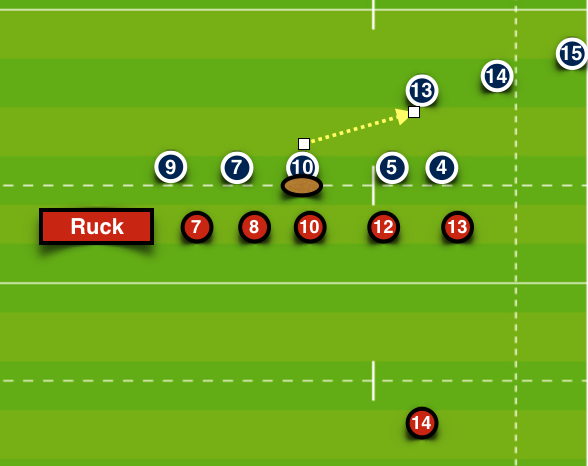
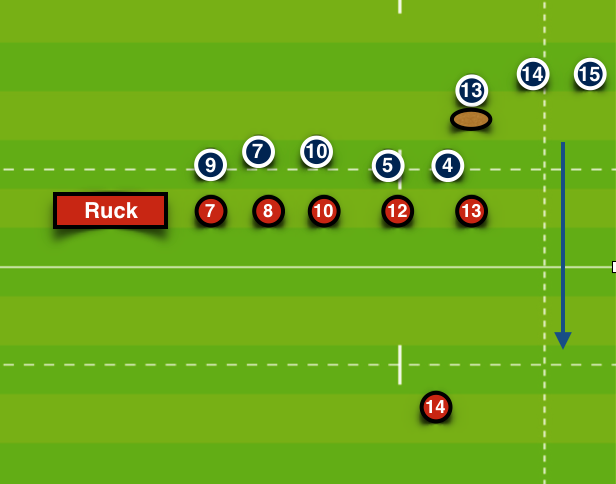
Lastly we look at kicking space and the onus is on the flyhalf to execute a kick between (grubber) or over the defenders with the players adopting the flat chase line.
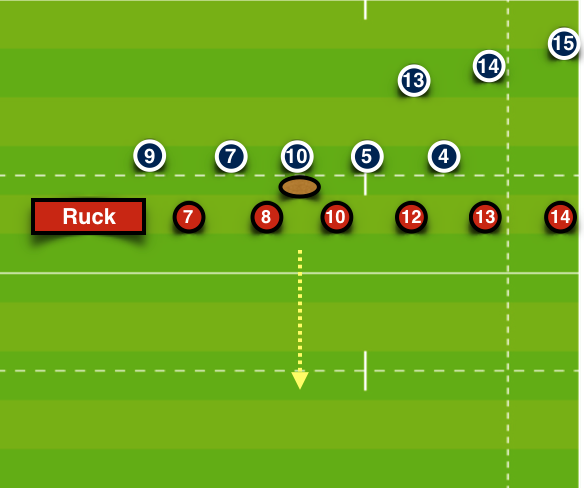
Progressions
Once players are familiar with the three environmental cues, progressions can take place to include varying numbers of attackers and defenders. Alternatively you may start with and play from a live tackle contest and breakdown to create quick ball (unbalanced defence) or slow ball scenarios (balanced defence). Additionally, two-sided attack from one of three different rucks (across the field) creates a dynamic and fluid environment closer to match conditions with multi phase decision making environments taking place.
This is where the creativity of attack comes into play and is the art of coaching in my opinion. I promote unstructured decision-making as the start point to get players used to making assessments and creating deliberate pressure before introducing decision-making within a pattern.
Skill essentials to consider in the process of coaching best option decision-making:
1. Passing: players need to be able to perform the basic skill of catching and passing accurately (hips square at pace) in order to utilise the width of the field (running or lateral space).
2. Evasion: players need to be able to hold the ball in both hands, stepping off either foot and fending with either hand in order to win the space between defenders, with a view to promoting the offload (channel or linear space).
3. Continuity: supporting players must adjust to the ball carrier in order to receive the offload, or to effectively remove the defensive threat should the ball go to ground. An effective first arriving player to a breakdown will ensure quick ball (less than 3 seconds to be cleared by 9) as well as preserve attacking numbers for continued support around the ball (time and numbers). Ineffective rucking requires extra bodies, diminishing the attacking potency.
4. Kicking: ensuring there are sufficient players across a team who can perform a variety of kicks (grubber, chip, pellet or kick pass).
I have included a final short video below of the Hudson Park 1st XV to give examples of the three scenarios described of creating and exploiting space.
Join me next time for best option decision-making at set piece and how to make decisions within a structured pattern of play.
James Winstanley
Level 3 Coach
Director of Rugby Hudson Park
Border Cravenweek Head Coach


Wow, Jimmy! Very interesting.
LikeLike